Top 10 Frauds in IndiaIn general, a fraud is referred to as a dishonest plot, an illegal conduct, or a fraudulent action. Fraud has a more detailed definition in the legal system. It refers to intentionally using deception or dishonestly robbing someone of a legal right. Frauds are also referred to as "white-collar crimes," which refers to offences with elements of dishonesty, secrecy, and breach of trust that are typically conducted by business professionals for financial benefit. A fraud comprises both civil and criminal components, each with its own set of punishments. For instance, a fraud that causes financial injury to a person would result in civil culpability as opposed to one that ends in breaking the law. We have all witnessed significant political and financial scams/frauds in our nation for many years that have included sums of money totalling millions of dollars. With so much cash on hand, it begs the question of whether India would still be in the developing stage today if the funds had been utilised for their intended purposes. The top 10 largest frauds that have affected our nation are listed here. 1. ABG Shipyard Bank Scam
Since its incorporation on March 15, 1985, the company has become a significant player in India's shipbuilding and repair industry. Their shipyards are in Gujarat, in Dahej and Surat. The company is renowned for producing newsprint carriers, self-discharging and loading bulk cement carriers, floating cranes, interceptor boats, dynamic positioning diving support vessels, pusher tugs, and flotilla for top businesses in India and overseas, according to India Today. In the last 16 years, the company, according to Times of India, has built more than 165 vessels. International classification organisations like Lloyds, American Bureau of Shipping, Bureau Veritas, IRS, and DNV have accredited and approved it. Facts: Since 1985, the ABG shipyard, a firm connected to the ABG group, has been engaged in the shipbuilding and repair industry. Rishi Kamlesh Agarwal served as the organization's previous chairman and managing director, and it operates two shipyards in Gujarat. The ABG Shipyard Scam, the largest banking fraud in India of Rs 22,848 crores, involves the company. The company obtained loans from a group of 28 banks during a five-year period, from 2012 to 2017, but did not use the funds for the intended purpose. Even during the 2008 worldwide deflation brought on by the fiscal crisis, which decreased demand for and the price of goods as well as cargo, the corporation took out loans. The shipyard industry was negatively impacted by this. The State Bank of India then made the decision in 2014 to restructure the loans issued to the company under the Corporate Debt Restructuring programme. Due to the company's financial difficulties brought on by the global fiscal crisis, it was deemed a non-performing asset since it was unable to make instalment payments. Consequences: As a result, SBI discovered the fraud in January 2019 and reported it. According to an Ernst and Young audit, there was evidence of fraud by the company between 2012 and 2017. Loan funds were misappropriated and diverted to be invested through foreign subsidiaries or shell companies, resulting in a criminal breach of trust with the intent to make money illegally off the loan funds. After requesting explanations from the SBI complaint that was filed in 2021, the CBI filed a FIR in February 2022. 2. Nirav Modi PNB Bank Fraud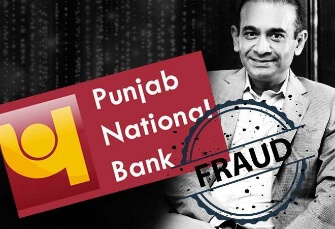
Facts: It is regarded as India's largest corporate fraud and rocked the nation's financial system. The prime suspect in the 14,000-crore-rupee scandal is the well-known jeweller and designer Nirav Modi. In January 2018, Nirav Modi's company Firestar Diamonds began to rise and grow internationally thanks to financing obtained through a buyer's credit from the Brady House branch of Punjab National Bank, which served as the importer's bank. A letter of undertaking that serves as a bank guarantee and places the borrower under obligation to repay the loan amount in the event of the borrower's default typically requires collateral or cash margin. The officials who came to ask for the buyer's credit for the loan that an international bank was providing claimed that they had previously received buyer's credit without any margins. Since then, because PNB's core banking system was not connected to SWIFT, a global messaging system for banks, letters of undertaking that are issued for a buyer's credit, a short-term loan, were fraudulently reissued. SWIFT is notified when a letter of undertaking is issued for money to be loaned from an overseas bank. Although the message of issuing a LOU via SWIFT did get through, it was not recorded in the bank's core banking system. Based on these LOU, money kept being sent to PNB's Nostro account, which is a foreign exchange account. Consequences: A fraud that lasted six years was the consequence of an unauthorised reissue of a LOU for jewels that was issued beyond the standard 90-day validity period, fake audits, certain personnel who colluded, and the use of shell businesses. Currently, the CBI and Enforcement Directorate are active in property attachments and auctions to reclaim properties. Now incarcerated is Nirav Modi, who fled to London. Although he has filed an appeal, an extradition pact between India and London has been approved to extradite him. 3. Karvy Stock Broking Limited
Facts: A sophisticated money robbery of Rs 2800 crores in the form of stocks was committed from April 2016 to October 2019. When Karvy Stock Broking Company first started acting as a middleman for retail investors to make stock market investments, it quickly became one of the most well-known retail brokerage companies. Investors began using Karvy for their stock transactions and conversions to Demat accounts because of its popularity and rapid expansion. Without the investors' knowledge or approval, they illegally obtained various bank loans using the securities they had placed in the company's trust, as well as the Power of Attorney they had granted. These loans are said to have been obtained to finance their real estate firm, Karvy Realty. The stockbroking company had no legal authority to interact with the Depository Participant accounts from which the stocks used for the loans were taken. These accounts were handled exclusively for any contractual obligations that clients had to fulfil. To present the shares as securities and secure loans against them, the company transferred the shares to a different Demat account under the name Karvy Stockbroking BSE. The diverted sum was never disclosed in reports submitted to the National Stock Exchange to avoid detection. Consequences: Even though this was a common market practise, SEBI issued a circular requesting stockbroking firm that deal in the securities of their clients to refrain from pledging securities. SEBI set a deadline for the securities to be sorted by September 30, 2019. Investors objected after Karvy failed to do so, and an investigation was launched. Karvy was prohibited by SEBI, the Bombay Stock Exchange and the National Stock Exchange removed the company from their membership, the securities were auctioned off, and the Union Ministry of Corporate Affairs was requested to investigate the company for financial fraud because of the few actions that followed. 4. Vijay Mallya Scam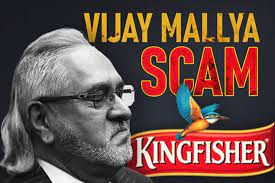
Facts: The notorious case of Vijay Mallya's money laundering of bank loans totalling Rs. 9081 crores (estimated amount, including interest) are well known. "The first businessman to be pronounced a Fugitive Economic Offender (FEO) under Section 12 of the Fugitive Economic Offenders Act of 2018," according to the tag. From taking over his father's company to growing it in the aviation and beverage industries. A 28-year-old man was witnessing the rapid expansion of his company and its success. Mallya acquired Air Deccan in 2012, during the collapse of the world aviation business, and as a result, he had to borrow money from 17 banks. He never paid back these loans, and by fleeing the nation, he managed to avoid capture. He owes more than Rs. 1600 crores to the State Bank of India alone. All this money is said to have been laundered abroad and invested in shell firms. There were rumours that the funds were used for IPL team-related transactions. The Force India F1 racing team and Royal Challengers Bengaluru. Consequences: Prior to his 2016 arrest, he fled to Britain, but a warrant was issued for his arrest under the 2002 Prevent of Money Laundering Act. Following that, he was arrested and later released on bail, which cost 65,000 pounds. He also had to turn over his paperwork. 5. Satyam Computers Scam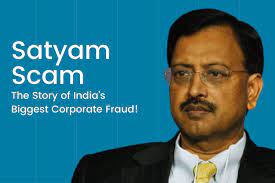
The 14,000 crore Satyam fraud represents the largest fraud to date in the Indian corporate sector. Ramalinga Raju, the disgraced former chairman, is accused of faking the books of accounts for a number of years and inflating Satyam's revenue and profit figures. After failing in his attempts to replace the "fictitious assets with genuine ones" through Matyas acquisition, he made the decision to come out and admit his guilt. Investors responded angrily and dumped shares, driving the fourth-largest IT company in India's market capitalization down by an astounding Rs 10,000 crore (Rs 100 billion) to Rs 39.95 on the Bombay Stock Exchange in a single day. Facts: One of the biggest corporate frauds in India was the Rs. 14000 crore scandal, which occurred between 2008 and 2015. B. Ramalinga Raju founded the Hyderabad-based IT business Satyam Computers in 1987. Between 1990 and 1991, the Bombay Stock Exchange Company listed it on the stock exchange. After that, Ramalinga Raju began purchasing properties all throughout India and registered them in his name as well as the names of several members of his family after noticing the rise in the price and demand for real estate. He created the Maytas Properties and Infrastructure. Ramalinga Raju began raising money to purchase these properties by falsifying and manipulating the financial statement demonstrating variations in Satyam Computers' profitability. The company's revenue, earnings, liabilities, and interests-all of which were displayed in inflation-were all misrepresented to the board, stakeholders, market, and investors. This misinformation caused share prices to soar, luring investors to Satyam Computers' stable financial foundation. Ramalinga Raju and his brother were forced to sell their shares as a result, and some further shares were pledged as collateral for a loan to purchase additional properties, particularly those that were associated with a sizable infrastructure project. Ramalingaraju fabricated fraudulent invoices and bank statements to make it appear as though his profits were kept as cash reserves in the bank while projecting himself as an active property buyer. This led to a significant discrepancy between the reported figures and the actual ones, which he attempted to close as the properties lost value because of the 2008 fiscal crisis. He tried selling his Maytas assets and infrastructure as a last resort, but this rendered him ineffective, and in 2009, he came clean about his misdeeds. Consequences: He and his associates received a 7-year severe prison term and a fine of $5 billion when SEBI and the CBI got involved. Companies must replace their auditors every ten years, according to SEBI. The fraud highlights the significance of strong corporate governance, which is necessary for all businesses and a warning indicator for all investors. 6. Harshad Mehta Scam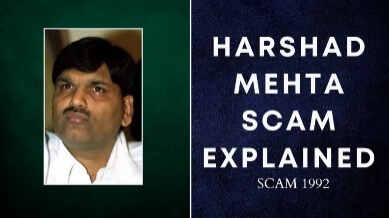
Facts: Popularly known as the Big Bull, Harshad Mehta took advantages of the loopholes in the banking system and triggered a rise in the Bombay Stock Exchange in the year 1992 by trading in shares at a premium across many segments. He and his associates diverted funds to the tune of about Rs 5,000 crore (Rs 50 billion) from the banks to stockbrokers between April 1991 to May 1992. He was later charged with 72 criminal offences. The massive scope of the Harshad Mehta scam alone brought down the stock market. This securities fraud was centred around government bonds, financial system flaws, and market manipulation. Harshad Mehta, a licenced stockbroker with the Bombay Stock Exchange, used the idea of ready-forward deals, in which the government sells securities for large projects while concurrently raising money from investors and charging interest on that money. These 15-day short-term loans entail the transfer of securities from one bank to another via bank receipts, which are then returned by the lending bank at a higher rate. Between the lending and borrowing banks, Mehta functioned as a middleman, stealing money to invest in the stock market and use it for his own gain. The borrower bank would issue bank receipts for the securities being transferred to the lender bank because there was no actual transfer of securities from one bank to another. Senior journalist Sucheta Dalal exposed a scheme that involved fake bank receipts, influential links among banks, bureaucrats, politicians, brokerage firms, and multiple bank workers. Consequences: Mehta and his brother served three months in prison following a CBI investigation, at which point the assets of the Mehta family were seized and they were accused of participating in 76 criminal cases, 600 civil lawsuits, and many tax evasions. This 1992 scam cost 4000 crores in losses and necessitated the revamping of India's entire banking system. It strengthened the Reserve Bank of India's involvement and authority by establishing a separate audio system and a new committee to oversee SEBI. 7. 2g Spectrum Scam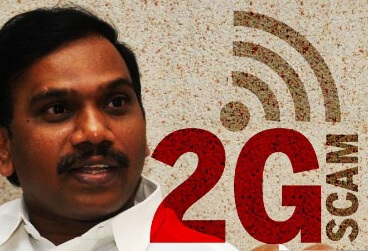
What more needs to be said about this swindle than has already been said? Recently, the Supreme Court declared that the spectrum fraud "puts all other frauds to shame." In the episode, the former telecom minister A Raja was forced to retire after the CAG indicted him in the 2G spectrum fraud that cost the national exchequer over 176,000 cores. The issue centres on suspected anomalies in the telecom ministry's allocation of wireless radio spectrum and licences to commercial operators, some of whom were ineligible. Due to the extremely cheap rates at which licences were granted and spectrum was allocated from 2001 in 2008, the national treasury suffered a monstrous loss. Facts: The largest instance of governmental corruption and significant anomalies indirectly resulted in the changing of the current administration. The Indian government and telecom department were devastated by the 7-year-long 2g Spectrum fraud. The second generation of wireless technology was established in 2008, and this lawsuit has a presumed loss of Rs. 1.76 lakh crores. To use the spectrum, telecom businesses and mobile providers needed a licence, which was acquired through a government-held auction. Andimuthu Raja, who served as the department's minister at the time, was charged with participating in this scheme because he stole a number of minute but crucial facts about the bedding that was kept in the facility. For instance, the minister allegedly moved a deadline for mobile carriers, Swan and Unitech, to pay him to the 25th of September. The deadline to apply with the DOT for the licence was originally set for the first of October 2007. Without following requirements like being able to cover 10% in the district headquarters in the first year and 50% in the district within three years, none of the enterprises requesting for licences were to be granted one. However, what happened was that some of the more recent businesses were operating without even a tower in place. For the benefit of these businesses, the licences were offered at the 2001 market price. The law, finance, and Telecom Regulatory Authority of India ministries were allegedly violated by A. Raja's actions. He allegedly put all the bribe money in foreign banks. As a result, he altered the regulations to provide licences based on bias and favouritism. Consequences: The Controller and Auditor General of India reported in 2010 that India had incurred a presumptive loss of Rs. 1.76 lakh crores because of using the market price from 2001, even though the accused were found not guilty on the grounds that a sum realised because of computing the loss using the 2008 market price was not evidence of a fraud. It was claimed that DOT employed such market prices to promote greater diversity rather than generate revenue, and that this was a premeditated strategy rather than a misuse of government authority. 8. The Commonwealth Games Fraud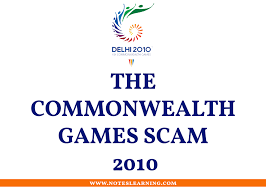
Of course, the con artists would have missed the much advertised and anticipated Commonwealth Games that India staged in 2010. Even before the eagerly anticipated sporting extravaganza could take place, it was doused in accusations of wrongdoing. The scandal, which involved money estimated to be worth close to 35,000 crores, involved irregularities, such as payments to non-existent parties, deliberate delays in contract execution, exorbitant prices, mistakes in the procurement of equipment through tenders, and money-laundering. Suresh Kalmadi, a former head of the Commonwealth Games organising committee, was arrested, and then charged by the CBI in April 2011. Facts: Every four years, the commonwealth games attract athletes from the numerous countries that make up the commonwealth nations. The Commonwealth Games were held in India's capital city of New Delhi in 2010. With a budget of twelve billion rupees, 71 different nations sent athletes to the commonwealth games. To support the multi-sport competition, 20 cities were created, and a Games Village was established. a committee led by Suresh Kalmadi, the mastermind of the Rs. 70,000 crore fraud, utilizing the chairman of the organising committee's arbitrary powers, the money was plundered during the planning stage. Initially sanctioned at Rs 1000 crores, the cost was eventually raised to Rs 2460 crores. In addition to the monies being misused, such as the contract offer of Rs 141 crores made by the chairman to Swiss Timings for timing equipment, which was deemed to be too exorbitant and unneeded, a number of political and administrative concerns also surfaced. The budget for providing these services for the tournament exceeded the amount that the government had previously allotted for them, and the money was misappropriated in the areas of bus services, metro services, and the opening ceremony. Several transactions were altered by utilising resources that were excessively expensive. Despite the expense, the venue's upkeep was delayed, suitable amenities were not given, there were numerous last-minute issues, and the programme management experienced a severe setback. Consequences: A Central Vigilance Commission investigation followed, which resulted in Kalmadi's removal from the committee, his arrest on April 25, 2011, and his suspension from the Congress Party. He was prohibited from attending the London Olympics' opening ceremony by the Delhi High Court in 2012. The Prevention of Corruption Act of 2002 charged the committee and Kalmadi with criminal conspiracy, cheating, and other offences. 9. Bofors Scam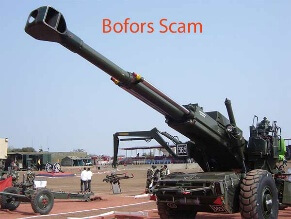
The Bofors scandal is regarded as the epitome of corruption in India. Rajiv Gandhi, who was prime minister at the time, along with other individuals, notably the influential NRI family known as the Hindujas, were charged with accepting payments from Bofors AB in exchange for gaining the contract to deliver India's 155 mm field howitzer. A shocking story of an undercover operation by Bofors, Sweden's largest arms manufacturer, in which it is claimed that $16 million was paid to members of Prime Minister Rajiv Gandhi's Congress, was broadcast by the Swedish State Radio. Facts: Indian National Congress and AB Bofors, a Swedish corporation that provided weapons and ammunition to the Indian Army, agreed to a deal for USD 1.4 billion. For the procurement of more than 400 155mm Howitzers, a contract was struck in 1986. The Indian Government invested a large amount of money because the supply was double what was specified in the contract. To pay for this deal, several projects had to be put on hold. Rajiv Gandhi, who was the prime minister at the time, came to national attention after a Swedish National Radio announcement. The Swedish corporation claimed that forty million dollars had been given to middlemen to help the sale go through. The Rajiv Gandhi administration refuted the allegations, but a report by Sweden's National Audit Bureau confirmed them along with the existence of undue influence. Consequences: Rajiv Gandhi was defeated by V.P. Singh in the ninth general election as a result. An article by "The Hindu" that exposed the fraud by way of the bank accounts connected to the purchase was published after the Swedish Audit report. This prompted the Controller and Auditor General to investigate the situation more thoroughly, which led to the discovery that the commission had been paid; however, the identity of the recipient could not be located. Since Bofors refused to budge, it was decided that the contract would be revoked, and the firm will be blacklisted unless the material is obtained. When the Ragive Gandhi Government unexpectedly ended the probe, Bofors made the decision to send a representative to handle the situation. The Hinduja brothers, Ottavio Quattrocchi, an Italian businessman, and other individuals were named in a FIR filed by V.P. Singh alleging abuse of authority, fraud, criminal conspiracy, and forgery. The CBI then began an investigation into the matter. Five Swiss bank accounts were frozen because of a CBI probe, and 18 names of potential middlemen were provided. Even though the case was dismissed due to a lack of evidence and investigation flaws. 10. Jeep Scandal
Facts: The oldest and first significant fraud committed in Independent India was in 1948. It was a political con that only the ignorant would fall for. During the Indo-Pak war, the Indian High Commissioner to Britain, V K Krishna Menon, was the primary offender. He signed a contract for 80 lakhs for reconditioned jeeps. He noted that even while the cost of the 2000 Jeeps was the same as the cost of new Jeeps that might have been imported from the USA or Canada, the delivery would be quick and include spare parts. Another error made by Krishna Mennon was that the original contract stated that only 65% of the money would be paid when a 20% inspection was complete and a certificate of the same was provided. Krishna Menon agreed to pay $172,000 in advance and allow only 10% of the total to be inspected without a certificate of inspection. Because the business delivering the jeeps had a capital of only $605, 155 jeeps that were supplied were in a condition that prevented them from being used. When the government refused to accept the non-operational jeeps, the business that had provided them, Anti-Mistantes, ceased deliveries. Menon's contract with the company was terminated, and he was forced to sign a new one with S C K Agencies for 1007 Jeeps. It was decided that they would be sent in increments of 12 per month for the first six months, then 120 jeeps each month, as necessary. However, just 49 jeeps were delivered over the course of two years, and the government was also not paid, especially in light of all the losses incurred as a result of prior contracts. Consequences: The fraud developed as a result of improper use of authority and influence on disregard procedures, money being paid advance, and the Prime Minister pressuring the government to accept the non-functional jeeps. The Ayyangar Committee investigated the fraud and produced data, but the administration rejected it so that the case could be closed. Causes for fraudsThere are numerous reasons why fraudsters engage in such criminal activities on several platforms, including banks and financial institutions, corporate governance, stock markets, and technology, aside from the fact that frauds are considered crimes and are done with malice. The desire for social acceptance and media attention are two examples of certain psychological elements. Most con artists have a plan to target those who are emotionally weak when it comes to their investments. They disregard standard due diligence and background checks because their desire for exclusivity and status consumes them. Most targets are blindsided by fraudsters' abuse of their position of authority because they see them as influential and powerful. The Indian financial sector and banks are regularly targeted because procedures and rules are not followed, there is poor corporate governance, and there is inadequate supervision. One of my biggest problems with frauds is that they almost always take advantage of flaws in the systems they target. ConclusionFraudsters have possibilities to perpetrate crimes because of legal loopholes. Even while changing and updating legislation to reflect societal changes is not the sole solution, such frauds show how frequently agencies fail to take their obligations seriously and arbitrarily abuse their authority. Although it can be difficult, these activities can always be corrected provided there is strict oversight that complies with all legal requirements. There is accountability where there is responsibility, and that would guarantee that all precautions are being taken to prevent any such abnormalities.
Next TopicTop 10 Games in India
|
 For Videos Join Our Youtube Channel: Join Now
For Videos Join Our Youtube Channel: Join Now
Feedback
- Send your Feedback to [email protected]
Help Others, Please Share










